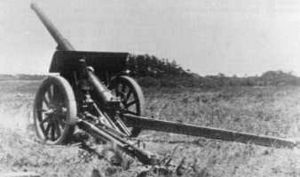Type 14 105 mm cannon facts for kids
Quick facts for kids Type 14 105 mm cannon |
|
|---|---|

Type 14 105 mm cannon
|
|
| Type | Field gun |
| Place of origin | |
| Service history | |
| In service | 1925-1945 |
| Used by | |
| Wars | World War II |
| Production history | |
| Designer | Osaka Arsenal |
| Produced | 1925-? |
| No. built | 64 |
| Specifications | |
| Mass | 3,116.7 kilograms (6,871 lb) |
| Barrel length | 3.556 metres (11 ft 8 in) L/34.2 |
|
|
|
| Shell | 15.77 kilograms (34 lb 12 oz) |
| Caliber | 105 mm (4.13 in) |
| Breech | interrupted screw |
| Recoil | hydropneumatic |
| Carriage | split trail |
| Elevation | -5° to +33° |
| Traverse | 30° |
| Rate of fire | 6-8 rounds/minute |
| Muzzle velocity | 620 m/s (2,034 ft/s) |
| Maximum firing range | 13,265 metres (14,507 yd) |
| Sights | Panoramic |
The Type 14 105 mm cannon was a large gun used by the Imperial Japanese Army. It was also known as the "10-cm" gun. This powerful weapon was designed for shooting targets very far away.
It was the first medium-sized cannon designed by Japan itself. It also had a special "split trail" design, which helped make it more stable. Even though it was a new Japanese design, it wasn't considered very successful. Later, a better gun called the Type 92 105 mm cannon replaced it.
Developing the Type 14 Cannon
Before World War I, the Japanese Army mostly used cannons made by a German company called Krupp. After the war ended, Japan started looking for new designs. They considered ideas from other countries, like France.
In 1925, the Japanese Army started using the "Type 14" cannon. Its design was based on some French ideas. However, the Type 14 cannon didn't work as well as they hoped.
Where the Type 14 Was Used
The Type 14 cannons were mainly used for training soldiers in Japan. They helped troops learn how to use large artillery pieces.
Related Pages
Images for kids


